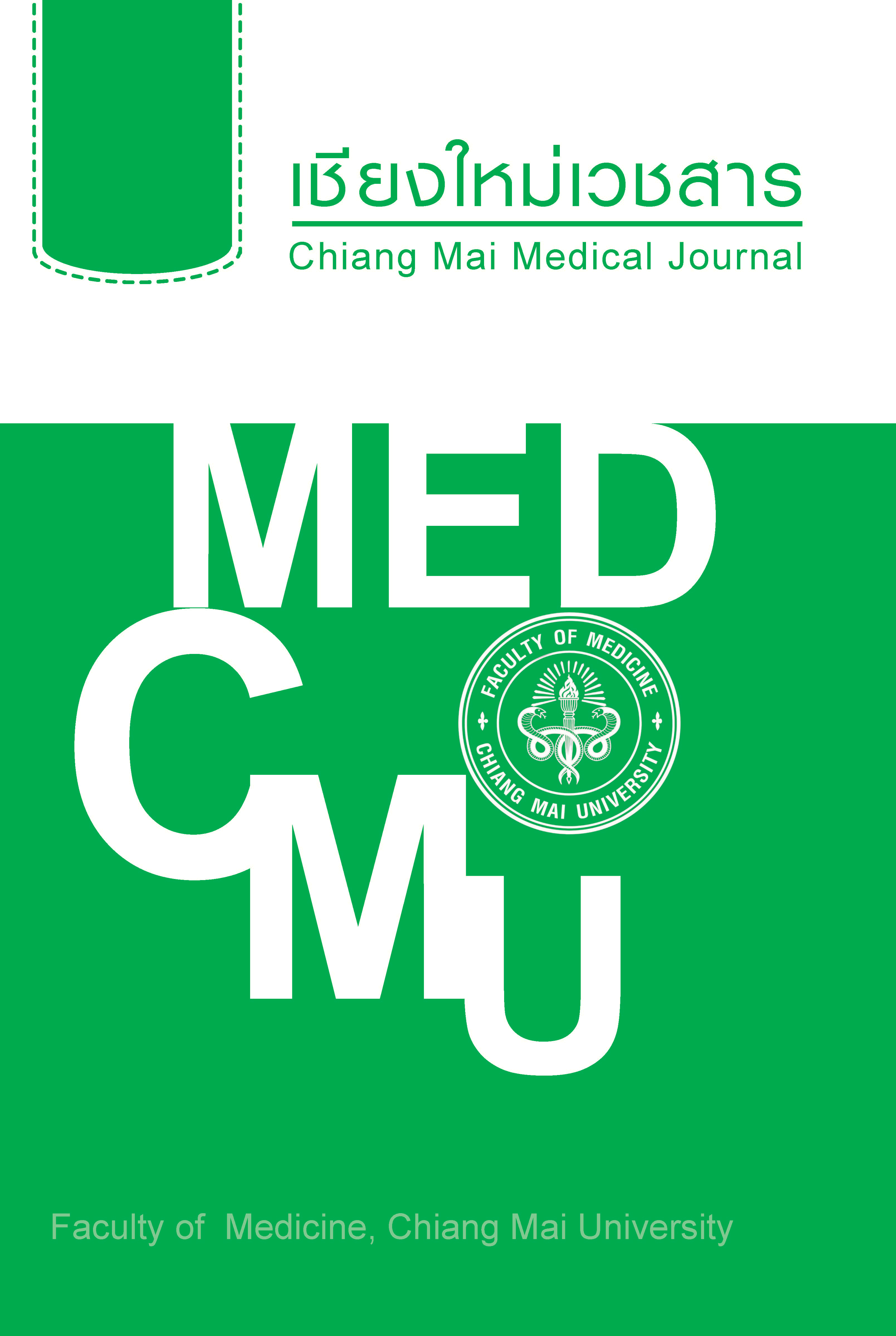The effect of dexmedetomidine on the vagolytic effect of pancuronium during propofol induction
Main Article Content
บทคัดย่อ
Objective To determine the effect of dexmedetomidine on the vagolytic effect of pancuronium
during propofol induction and the hemodynamic responses to intubation in normotensive patients
plus the effects of dexmedetomidine on the action of pancuronium
Methods Forty-four American Society of Anesthesiologists (ASA) class I and II adults were included
in this randomized, double-blind controlled trial. Patients with hypertension or preexisting bradycardia/tachycardia were excluded from the study. On arrival at the operating room, participating
patients received a 20 ml infusion of either saline (Group C, n=22) or Dexmedetomidine 0.7 μg/kg
(Group D, n=22) over a period of 10 minutes followed by propofol induction. Calibration of the
twitch response of the adductor pollicis muscle was then performed followed by injection of pancuronium 0.12 mg/kg. Endotracheal intubation was accomplished 2.5 minutes after the injection.
Initial blood pressure (BP) and heart rate (HR) were measured and recorded for baseline control.
BP and HR were measured again at completion of drug infusion, 2.5 minutes after pancuronium,
immediately after intubation, and then each minute for the next 5 minutes for a total of 5 times
(T0-T5). Also recorded was the twitch height of the adductor pollicis muscle at the time of intubation
and the duration of action of pancuronium.
Results The HR in Group D was lower than that of Group C at 2.5 minutes after pancuronium
(75.7±9.3 vs 88±12.9 bpm, p=0.013) but not different from its baseline. After intubation, HR at
T0-T5 were comparable between groups. BP did not differ signi fi cantly between the groups during
the entire study. In Group C, however, systolic BP at just before intubation was signi fi cantly lower
than baseline (106.4±12.0 vs 121.0±13.9 mmHg, p=0.001). None of the patients needed treatment
for hypo/hypertension or brady/tachycardia. At the time of intubation, Group D had a higher percentage of patients with a twitch height <10% than Group C (92 vs 67%, p=0.048). The duration of
action of pancuronium was not different between the groups.
Conclusions In normotensive patients, dexmedetomidine 0.7μg/kg infusion prior to propofol induction effectively reduces the vagolytic effect of pancuronium prior to intubation but does not blunt
the blood pressure responses to intubation. It also quickens the onset of pancuronium but has no
effect on its duration.
during propofol induction and the hemodynamic responses to intubation in normotensive patients
plus the effects of dexmedetomidine on the action of pancuronium
Methods Forty-four American Society of Anesthesiologists (ASA) class I and II adults were included
in this randomized, double-blind controlled trial. Patients with hypertension or preexisting bradycardia/tachycardia were excluded from the study. On arrival at the operating room, participating
patients received a 20 ml infusion of either saline (Group C, n=22) or Dexmedetomidine 0.7 μg/kg
(Group D, n=22) over a period of 10 minutes followed by propofol induction. Calibration of the
twitch response of the adductor pollicis muscle was then performed followed by injection of pancuronium 0.12 mg/kg. Endotracheal intubation was accomplished 2.5 minutes after the injection.
Initial blood pressure (BP) and heart rate (HR) were measured and recorded for baseline control.
BP and HR were measured again at completion of drug infusion, 2.5 minutes after pancuronium,
immediately after intubation, and then each minute for the next 5 minutes for a total of 5 times
(T0-T5). Also recorded was the twitch height of the adductor pollicis muscle at the time of intubation
and the duration of action of pancuronium.
Results The HR in Group D was lower than that of Group C at 2.5 minutes after pancuronium
(75.7±9.3 vs 88±12.9 bpm, p=0.013) but not different from its baseline. After intubation, HR at
T0-T5 were comparable between groups. BP did not differ signi fi cantly between the groups during
the entire study. In Group C, however, systolic BP at just before intubation was signi fi cantly lower
than baseline (106.4±12.0 vs 121.0±13.9 mmHg, p=0.001). None of the patients needed treatment
for hypo/hypertension or brady/tachycardia. At the time of intubation, Group D had a higher percentage of patients with a twitch height <10% than Group C (92 vs 67%, p=0.048). The duration of
action of pancuronium was not different between the groups.
Conclusions In normotensive patients, dexmedetomidine 0.7μg/kg infusion prior to propofol induction effectively reduces the vagolytic effect of pancuronium prior to intubation but does not blunt
the blood pressure responses to intubation. It also quickens the onset of pancuronium but has no
effect on its duration.
Article Details
รูปแบบการอ้างอิง
1.
Lapisatepun W, Pipanmekaporn T, Threesuthacheep C, Wisadekarn K. The effect of dexmedetomidine on the vagolytic effect of pancuronium during propofol induction. BSCM [อินเทอร์เน็ต]. 1 เมษายน 2017 [อ้างถึง 27 ธันวาคม 2025];56(2):81-8. available at: https://he01.tci-thaijo.org/index.php/CMMJ-MedCMJ/article/view/92738
ประเภทบทความ
Original Article


